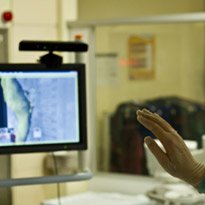Surgeons at Guy’s and St Thomas’ NHS Foundation Trust are piloting touchless IT in the operating theatre based on Microsoft’s Kinect gaming technology.
Developed in partnership with Microsoft Research, King’s College London and Lancaster University, the technology allows surgeons to view, control and manipulate medical images without touching a screen or computer keyboard.
Guy’s and St Thomas’ clinical fellow Neville Dastur told eHealth Insider he had first used the technology in a live environment at the trust in May.
Dastur, who is also a surgeon at Brighton Sussex University Hospitals, said an imaging team had been developing technology to show 3D images in complex aneurysm procedures by overlaying live images with a 3D scan taken before the operation.
It soon became apparent that surgeon needed to be able to move the images around themselves, as Dastur found himself constantly “shouting across the room to ‘go left’ or ‘go right a bit’.”
However, they could not touch the screens because of infection control issues. Dastur said the team looked at a number of different technologies before deciding to investigate using Kinect.
Surgeons and developers got together with the Microsoft team about a year ago to work on what gestures would be needed to rotate, pan and zoom on the medical imaging system.
In the first live trial, Dastur operated the touchless technology in real time while another surgeon did the operation. He said it was not yet ready to be used in an actual surgery, but everything had gone fantastically well in the trial run.
Dastur believes the surgery represents a “massive step forward.” “The whole concept of doing things without touching things is here to stay,” he explained. “In the environment we are working in it’s going to be of tremendous benefit.”
Microsoft Research Cambridge post-doctoral researcher Helena Mentis said the aim of the project was to look at the challenges of retaining a sterile surgical environment.
“If you look at all the people who are really interested in this space right now, it really is something that has immediately caught the attention of pretty much every hospital in the Westernised world,” she said.
Mentis said the team was also working with neurosurgeons at Addenbrooke’s Hospital in Cambridge to use the technology in the manipulation of 3D volumetric models of the brain.
King’s ultimate aim is to develop a touchless interaction in surgery toolkit that can be used in any hospital or system interested in applying touchless interaction to their imaging system.
The gesture-based system uses Microsoft Kinect for Windows hardware and the Kinect for Windows Software Development Kit.

